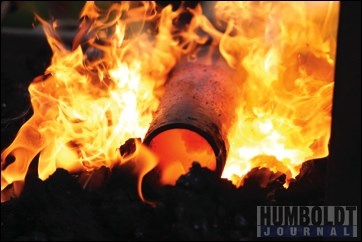For many people, blacksmithing is a profession that's been frozen in time for centuries. It conjures up images of bearded men sweating over a hot furnace, building broadswords and battle axes.
At Murray Cook's house, just east of Humboldt, there were bearded men and fires, but the end products were more diverse - bells and knives instead of weapons of war.
Cook has been hosting what he calls a "blacksmith's symposium" for the past several years. The events are designed as a sort of retreat, a place where smiths come together to talk shop, compare notes and fire up their forges.
About 15 people attended this year's workshop, conducted under the umbrella of the Western Canadian Blacksmith Guild.
In Cook's huge garage they pored over drawings and debated designs for the projects they were about to forge. Many asked for help or guidance from Doug Newell, who came from Cochrane, Alta. to serve as a kind of mentor and guide.
"The most important thing I can teach these guys is to go into it with a plan," Newell said. "You don't want to be deciding what to do once you've got a fire going."
In a back corner of Cook's large garage, Newell showed off some of his creations. There was a candleholder that weighed as much as a sack of potatoes and a small pocketknife.
"I'd make about a dozen of these at a time," Newell said as he fingered the blade.
Also in that back corner and eager to talk about their love of blacksmithing were Zach Hauser and Al Bakke. Hauser, a thin furniture maker who wore overalls, said he was drawn to the craft after he started making kitchen knives to satisfy his other hobby, cooking.
"Why do people do anything?" he said when asked why he'd picked up blacksmithing. He shrugged his shoulders and laughed. "It's brain candy!"
Next to Hauser was Al Bakke, a 76-year-old bundle of energy who wore a leather hat and orange-tinted glasses. Bakke has been retired for 22 years but hasn't had any problems filling his days.
"You go to bed giggling," he said of the thrill of crafting something out of metal. "A lot of people retire and work at Wal-Mart for a year before they get bored. I've been retired for 22 years and I've still got lots to do!"
Without being prompted, Bakke offered to demonstrate what was by far the smallest forge among the 10 or so spread out under a wooden roof in Cook's yard. It was a single brick, wrapped in metal and with holes on one side and one end. Next to the brick was a small canister of propane, which when lit supplied the brick-turned-forge with heat.
"A lot of people don't think I can make anything with this tiny thing," Bakke said as he picked up a small piece of steel, about six inches long, and slid it into what had quickly become a white-hot inferno. The heat escaping from the open end of the brick gave a shimmering quality to the air and it wasn't long before Bakke was pulling out the small piece of steel, the end cherry red and soft.
Bakke wasn't sure what he was going to make, but a lot of his work, like Hauser, is in knives. He pulled a small one out of a pouch on his belt and explained why he doesn't worry about safety concerns.
"Who the hell's gonna bug me about walking around with a knife?" he asked with mock indignation. "I'm 76 years old."
All around Bakke other blacksmiths were preparing their forges. Most were quite large, with a surface area at least the size of an average barbecue. Many had a crank on one end that fed oxygen to the fire as they were turned; thick and acrid smoke billowed from each forge, eventually clearing as the coal-fueled fires began to burn hot.
"Most people use coal, but propane is a bit easier to work with," Cook said as he turned the crank on his forge. "Propane burns a little cleaner and it can be safer. Coal fires get very hot and if you don't know what you're doing it can be dangerous."
Fortunately, most of the men (yes, they were all men) seemed to know what they were doing. Each was working on something a little different - one pair was forging a bell. Once the raw metal was red-hot, Newell, the demonstrator, lent a hand. He carried the piece into Cook's garage and placed the hot part carefully under one of the room's many machines.
The machine whirred into life and began to shape the piece of metal into the form of a bell by smashing down onto it with a block of steel. The process looked imprecise, but was anything but; Newell turned the piece ever so slightly as the hot metal began to wither under a relentless attack.
When he was satisfied with the work, Newell dropped the piece into a barrel of water that hissed like an angry rattlesnake as the future bell began to cool. It was still far from completion, more first steps than final touch-ups.
Out in the yard, the other blacksmiths continued to stoke their fires and patiently hammer away, creating something one blow at a time. They weren't making broadswords or battle axes, but it was exciting just the same.




